Hearty, wholesome, and packed with Mediterranean flavor, Greek Giant Beans (Gigantes Plaki) are comfort food at its finest. Baked in a rich tomato sauce with herbs and olive oil, they’re simple, satisfying, and perfect with crusty bread.

Jump to:
What are Greek giant beans
Greek giant beans (known in Greek as "Gigantes Plaki" or simply "Gigantes") refer to both the type of bean used in it and the dish.
The bean: Gigantes beans (pronounced YEE-ghan-dess) are large white beans, similar in appearance to lima beans or butter beans but often meatier and creamier in texture. They are typically dried beans, soaked and then cooked slowly, absorbing rich Mediterranean flavors.
The dish: This is a traditional Greek baked bean dish. The beans are simmered until tender, then baked in a tomato-herb sauce, often until slightly caramelized on top.
It’s a staple of Ladera cooking (vegetable-based dishes made with olive oil) and is naturally vegan. Typically served as a main course, mezze (appetizer), or side dish, either warm or at room temperature, with crusty bread.
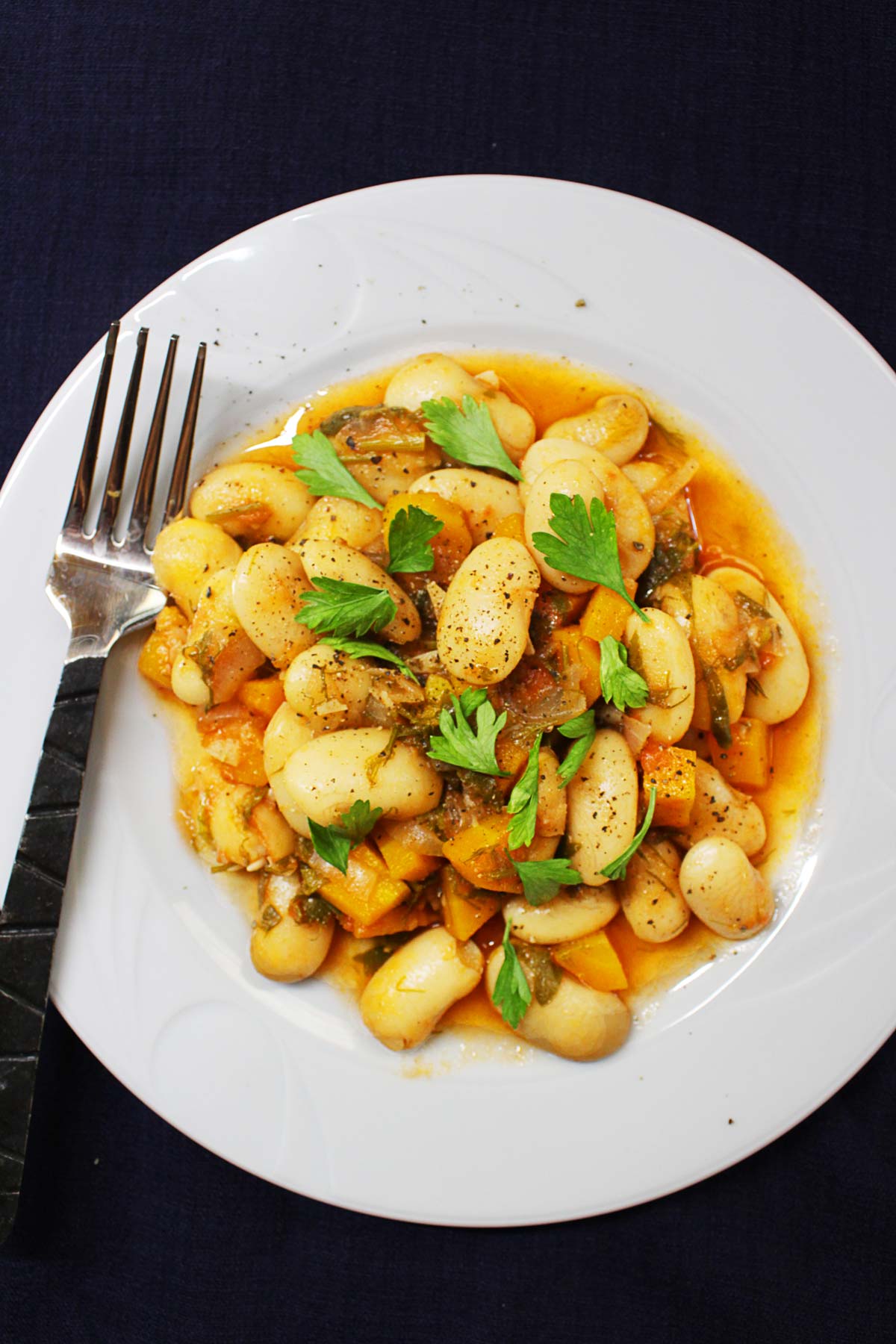
The role of beans in the Mediterranean way of eating
For centuries, beans have been a staple in Greek Mediterranean cuisine mainly because they were cheap and filling, meaning they were feeding multiple family members when people faced extreme poverty and starvation.
Therefore, they used to keep beans and legumes/pulses in their store room (usually in the cool basement of their house) in order to cook them according to the seasonal vegetables from their garden and herbs from all over the countryside.
Apart from the obvious economic reasons, their consumption was very popular for religious reasons, too. Imagine long periods of fasting where animal products were strictly off the menu, and even those who could afford to put meat on the table abstained almost 200 days per year.
Beans were the perfect choice for the family menu and the main source of protein, so the house cooks constantly attempted new ways of cooking and made delicious combinations out of their poor pantry.
That’s why Greek Mediterranean cuisine nails bean recipes—seriously, nobody does legumes like the Greeks. And here’s a fun fact to drop at your next dinner party: Greece’s national dish isn’t moussaka or souvlaki dripping in tzatziki. Nope. It’s a humble, hearty white bean soup called fasolada that warms bellies and hearts alike. Beans, not beef, are the true Greek royalty!

Key ingredients
Here are the key ingredients for making traditional Greek Giant Beans (Gigantes Plaki)—each one plays a role in building that rich, comforting, Mediterranean flavor:
The beans
The best Greek giant beans come from the wetlands of Prespes in Northern Greece. They are awarded a PGI (Protected Geographical Indication) product. Their unique flavor originates from the nutrient-rich soil and the unique microclimate of the area.
Unfortunately, production is extremely low, and Greece has to import large amounts to cover local consumption. It’s more likely to eat imported giant beans from Turkey, which are fine, but if you ever find beans from Prespes, go ahead and try them. Highly recommended!
If you cannot find giant beans, try large lima or butter beans instead. I suppose it will be easy to find them in supermarkets or buy them online. In Greece, you may purchase giant beans in bulk, and they are cheaper, but you have to find fresh ones. Otherwise, the cooking time will be long, like forever.
Can I use canned beans?
Truth be told, I am not sure!
I have never used canned beans in my life, and I am not familiar with their taste. I live in Athens, and it is still difficult to find a variety of canned products. You see, Mediterranean food is all about fresh and minimally processed food, and canned items aren't popular.
Therefore, I cannot guarantee that your dish will be a success. Still, you save time, so this is important for some of you. So, just drain and rinse them well before baking. If they are too salty, adjust the salt accordingly. Toss them in the baking pan with the rest of the ingredients. Tell me in the comments how it went and if you liked the taste and texture.
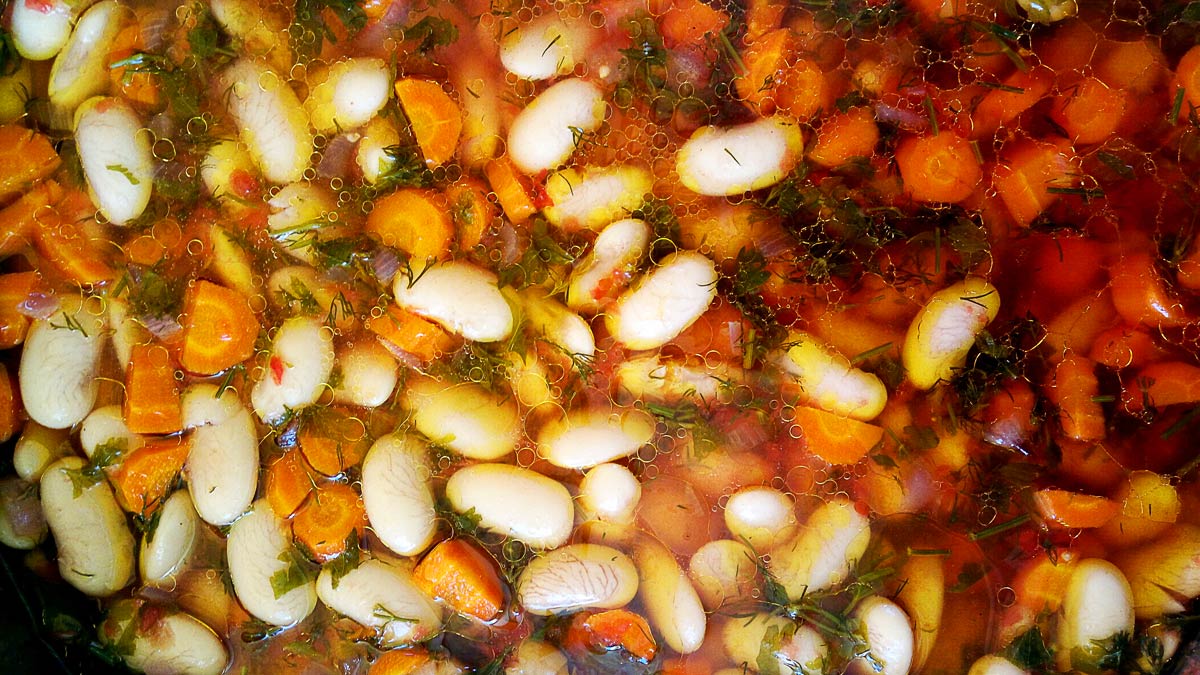
The rest of the ingredients
Onion (yellow or red): It provides a sweet, savory base for the sauce.
Carrot: It adds natural sweetness and balances the acidity of the tomatoes.
Fresh tomatoes or canned tomatoes: After beans, they are the most important ingredient. A mix of crushed tomatoes or grated fresh, plus a bit of tomato paste, works beautifully.
Bay leaf: may not steal the spotlight, but it works behind the scenes like a pro, gently infusing the beans with a subtle, earthy aroma as they simmer.
Fresh dill: It adds a signature Greek twist—bright and slightly tangy.
Fresh parsley: It brings freshness and balance.
Olive oil: It coats the beans in richness, helps the sauce caramelize beautifully in the oven, and brings that unmistakable Mediterranean silkiness to every bite. Use a high-quality extra virgin olive oil, and be generous—this dish loves it.
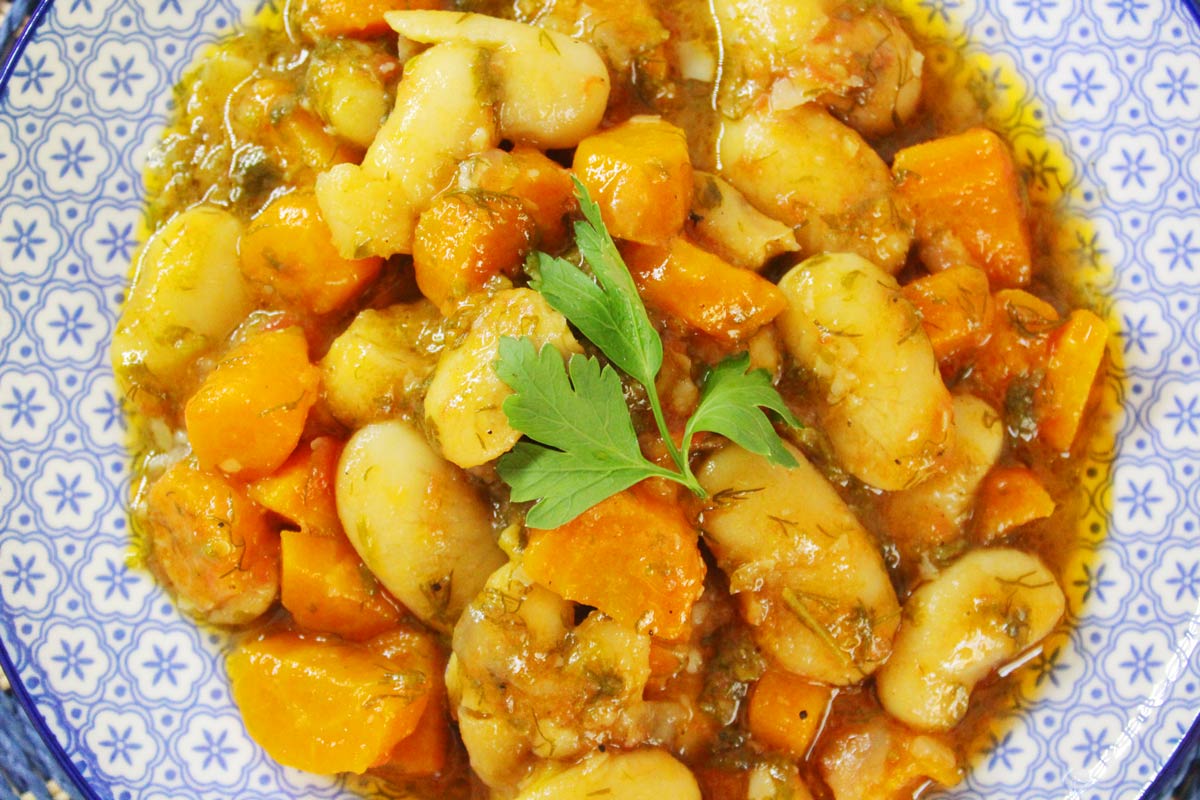
Meal prepping this recipe
Soak the beans ahead of time and cook them in advance. Then, chop your veggies and herbs and store them in airtight containers in the fridge for up to 3 days.
Finally, assemble and bake when ready.
Substitutions and variations
For the beans: If you can’t find traditional gigantes beans, don’t worry—large lima beans or butter beans make excellent substitutes with a similarly creamy texture.
For the herbs: the classic duo is dill and parsley, but don’t be afraid to play around—try thyme or rosemary for a more earthy profile.
For the veggies: This recipe also welcomes extra veggies—chopped zucchini, spinach, red bell peppers, or mushrooms add variety and boost nutrition. If you like a little heat, throw in some red pepper flakes, Aleppo pepper, or smoked paprika for a subtle kick. And for those craving a cheesy element, crumbled feta on top (added before or after baking) is delicious.
Finally, while the dish is naturally hearty and protein-rich, you can bulk it up further by mixing in cooked chickpeas. If you’re not sticking to the traditional plant-based version, add a good-quality sausage. Ask for a Greek "horiatiko loukaniko" (village sausage) in a Greek deli and you will get a whole new gastronomic experience. I assure you!
How to make Greek giant beans
To begin with, this giant bean recipe is super basic but ...amazing in its simplicity! Let's make it together:
Step #1: Soak the beans overnight
I always soak the beans overnight for at least 12 hours to make them more digestible and to reduce the cooking time.
Soaking beans is an important step. Gastrointestinal discomfort is no joke at all. From bloating and indigestion to stomachaches and that heavy feeling, gastrointestinal issues can put a damper on your day.
Step #2: Simmer the beans in water
Start by simmering the soaked beans for 30 minutes to 1 hour. If they’re fresh, they’ll usually be ready closer to the 30-minute mark. If they take longer than an hour to soften, chances are the beans are older and will need significantly more time—and even then, they might never reach that perfect creamy texture you're after.
So, how do you know they’re ready?
Do the fork test: press one bean gently with a fork. It should squash easily but still hold its shape, not completely mushy. That’s the sweet spot. Undercooked beans will stay too firm in the oven, and overcooked ones will turn to paste. Look at the pictures below and aim for that balance.
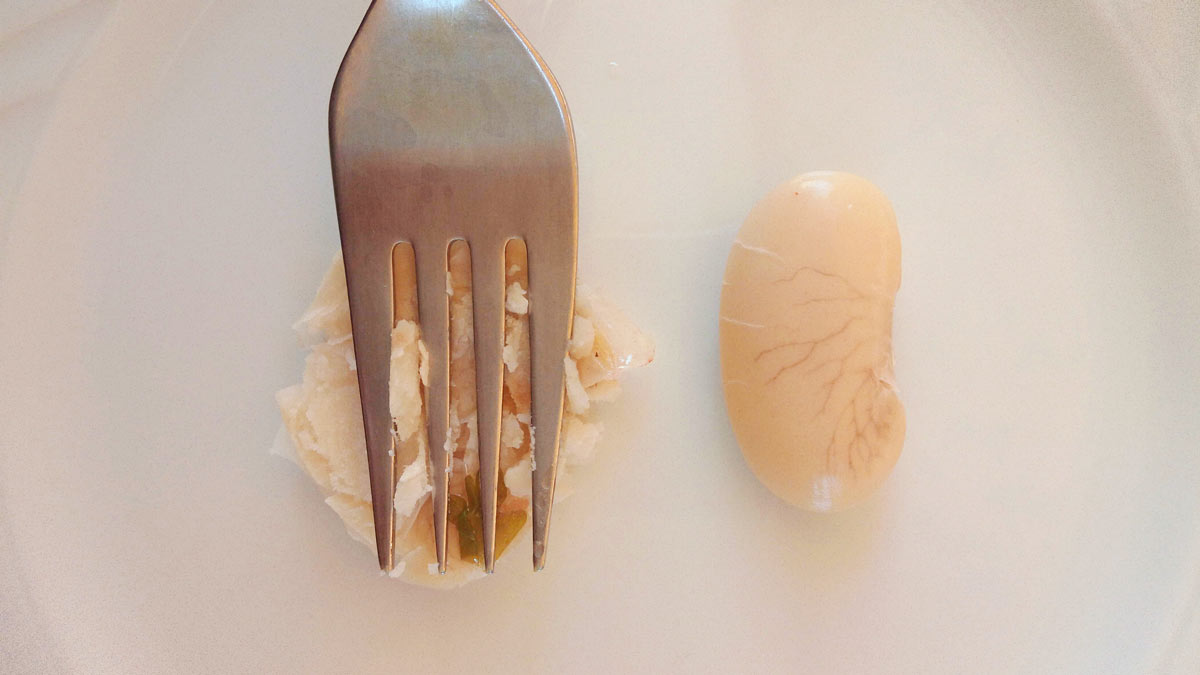
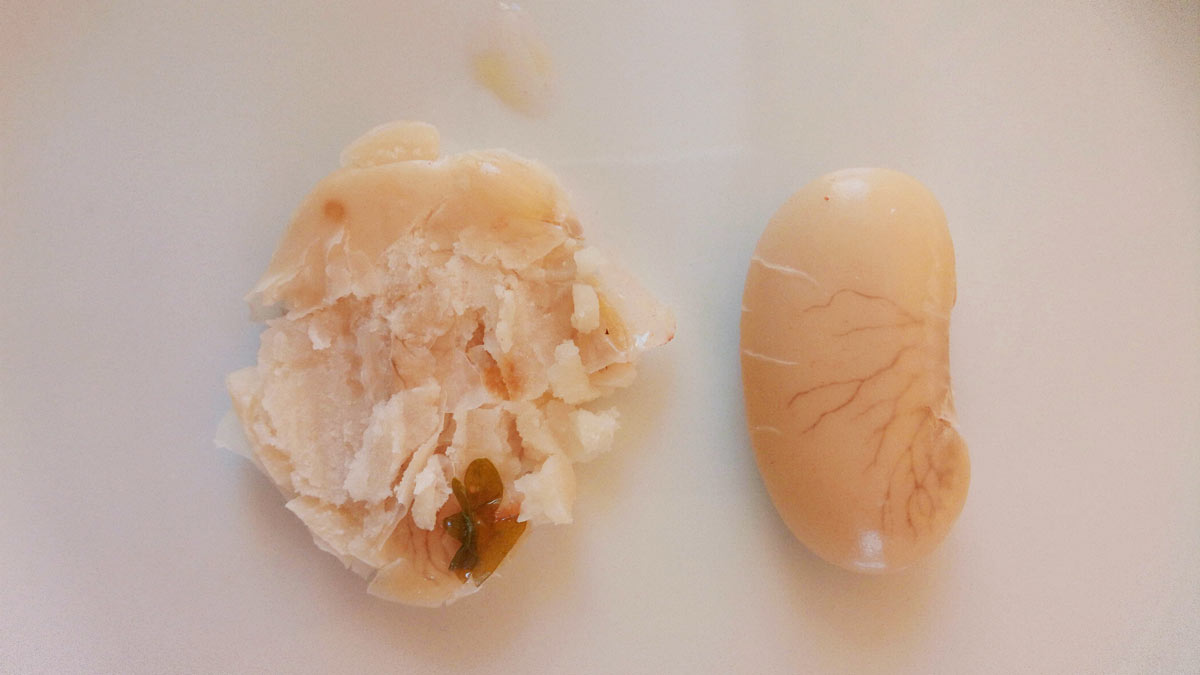
Step #3: Bake
Use a baking pan or dish and add the beans with the rest of the ingredients. Pour in water from the simmered beans and toss well. The liquid should cover the beans.
Ready in an hour or so!
Expert tips
How to purchase the best beans: When buying giant beans, avoid ones that look yellowed or cracked—this is a sign they’re old. Aged beans are much harder to cook and may never soften properly. If you're buying them in bulk (not pre-packaged), test one by biting or breaking it: if it shatters like a dry candy, it's likely too old and won’t cook evenly. A good bean should be firm, but not dry at the core.
Add salt at the perfect timing: Don’t add salt to your pot of simmering beans because it takes more time to soften. Add a bay leaf instead to enhance the beans' aroma. We add salt at the end (see the recipe card).
Simmer gently: When cooking, keep the heat low and steady. Gentle simmering allows the beans to soften evenly and become creamy. High heat, on the other hand, causes the skins to split while the centers remain undercooked.
Simmering time is important: The only real challenge with this recipe is the simmering time, and that depends entirely on the variety and freshness of your beans. The goal is to get them soft enough to be creamy, but not so tender that they fall apart in the oven.
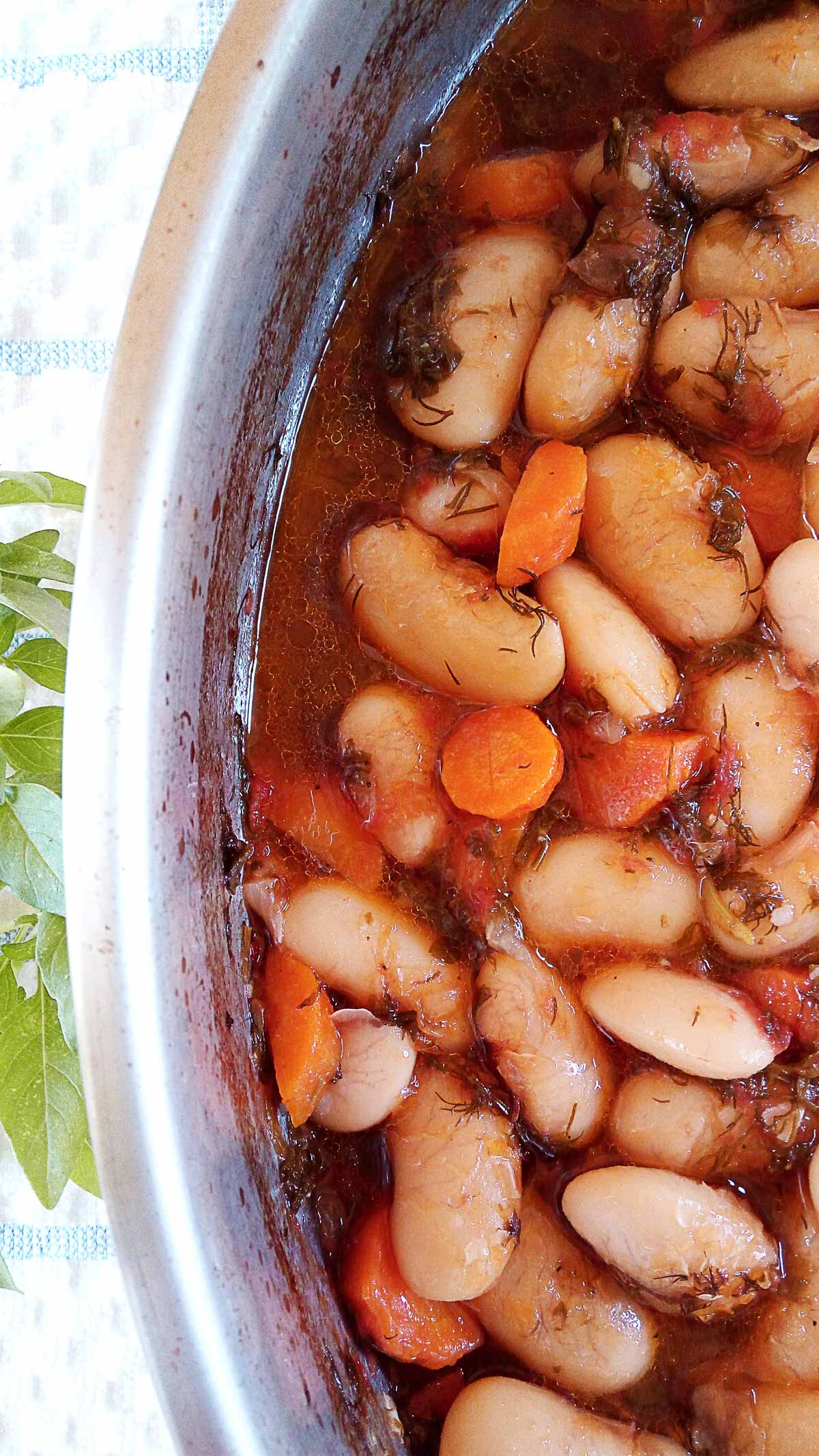
How Greeks serve giant beans
I know you want to serve them immediately or even start eating from the pan, but please, be patient. At least 15 minutes, ideally 30 minutes. Give time so that the beans absorb more of the divine tomato-olive oil sauce.
In Greece, Gigantes Plaki is more than just a dish—it’s a staple of the mezze table, a comfort food on chilly days, and a shining example of plant-based Mediterranean cooking.
At a taverna, you might find it as part of a mezze spread, surrounded by olives, pita bread, feta cheese, and maybe some grilled vegetables. At home, it's often enjoyed as a main dish, especially during periods of religious fasting (like Lent), paired with a simple green salad, a slab of feta, and always—always—a generous hunk of country-style bread to mop up that luscious sauce.
For the wine, I suggest a cool, fruity Sauvignon Blanc.
How to serve leftovers
Leftover gigantes? Lucky you! This is one of those dishes that tastes even better the next day as the flavors deepen and the sauce thickens. Simply reheat gently in a skillet or in the oven with a splash of water or olive oil to loosen the sauce.
You can enjoy them warm as a main or side dish, or serve them at room temperature as part of a mezze spread. Add a crumble of feta, a few fresh herbs, or a squeeze of lemon for a bright, fresh twist. They’re also fantastic tucked into a warm pita with some greens or served over toast for a quick, hearty lunch (Look how my son is drooling over the mezze spread below)!
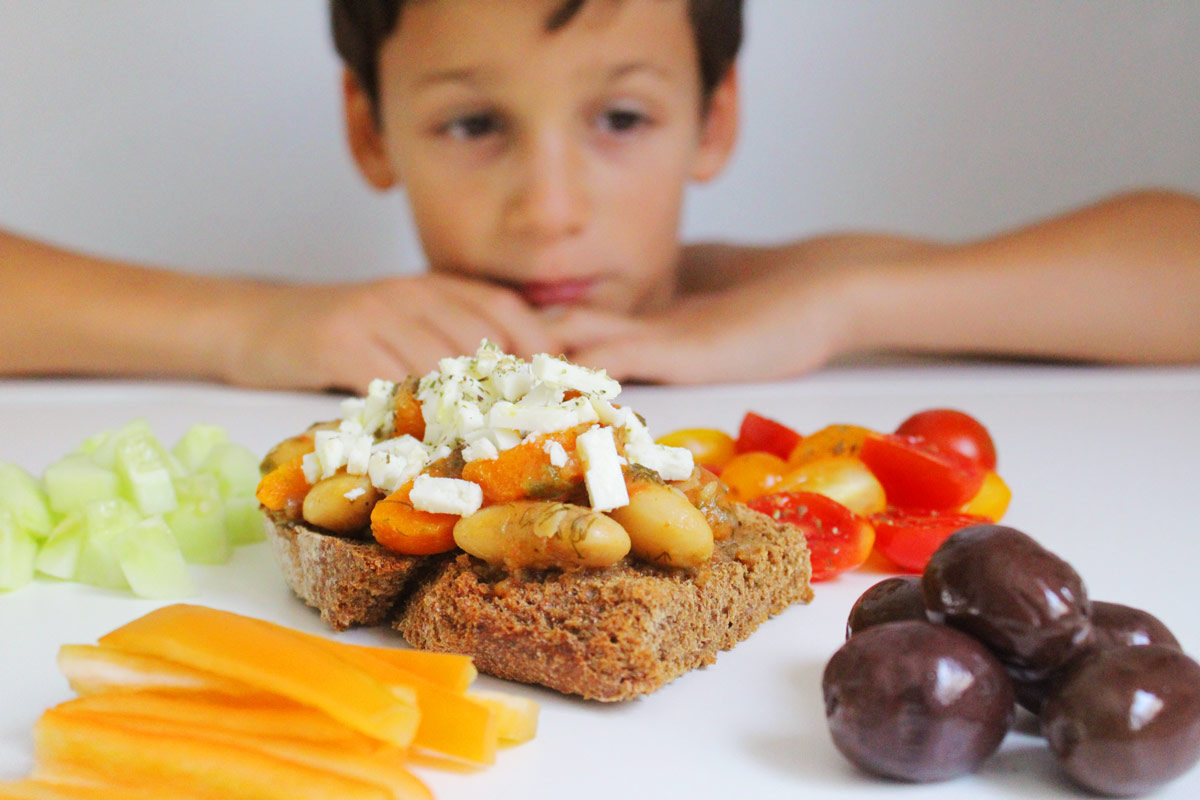
How to store and freeze
Store leftover gigantes in an airtight container in the refrigerator for up to 4 days. They keep well and are great for quick meals throughout the week.
To freeze, let the beans cool completely, then transfer them to freezer-safe containers or bags, ideally in portion sizes. They can be frozen for up to 3 months. When you're ready to eat, thaw overnight in the fridge and reheat gently on the stovetop or in the oven, adding a bit of water or broth to bring back their saucy texture without drying them out.
More ladera dishes
If you’ve fallen for the rich, olive oil comfort of gigantes plaki, you’re in for a treat. Greek cuisine is full of “ladera” dishes, a beloved category of traditional meals where vegetables are cooked slowly in olive oil and tomato, often until meltingly tender.
I would love to hear your feedback. It keeps my kitchen alive and my spirits high. Save this recipe and leave your rate and comment below, or take a photo of your Greek giant beans and tag me on Instagram with #30daysofgreekfood and Facebook with @30daysofgreekfood.
Enjoy!!!
Recipe
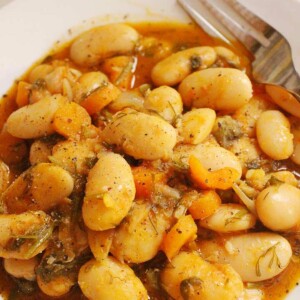
Greek Baked Giant Beans – Gigantes
Ingredients
- 1 pound (500g) dried giant beans or large lima or butter beans
- 5 cups (1.200ml) water or vegetable stock
- 1 bay leaf
- ⅓ cup olive oil
- 6 medium carrots, chopped
- 1 big onion, chopped
- 8 tablespoons fresh dill, chopped
- 6 tablespoons fresh parsley, chopped
- 2 cups (400g) fresh tomatoes or one can chopped tomatoes
- 2 teaspoons tomato paste, dissolved in water (optional)
- Salt and pepper to taste
Instructions
- Soak dried beans overnight for at least 12 hours.
- Drain, raise, place them in a pot, and pour in the water. Add the bay leaf. When the water comes to a boil, simmer over low-medium heat. Remove the white foam that usually surfaces on top of the water.
- Simmering time varies from half an hour to one hour.* To check if the beans are ready, squash one bean with a fork. It has to be soft enough to be squashed but not mashed (see the photo at step #2).
- Reserve 3 cups of the cooking liquid.
- Preheat your oven to 200°C (390°F).
- Layer semi-cooked giant beans in a baking pan/dish (I use a round one) and add the rest of the ingredients with 2 cups of liquid from boiled beans. The liquid should cover all the beans. Season with salt and pepper.
- Place the baking pan in the middle of the oven and cover it with parchment paper and aluminum foil.
- Bake for about 1 hour. Taste the beans every 15 minutes. When they soften, remove the aluminum foil and bake for 15 minutes. Add more liquid if you want more sauce, but it has to be hot (water, broth, or the remaining cooking liquid).
- Sprinkle some fresh chopped parsley, feta cheese crumbles or blocks, crusty bread, and a glass of white wine. Drizzle more olive oil if you like.
- Serve hot or at room temperature.









Linda Torn says
I have started using the dry Gigantes. I love them in a tomato sauce much like the one you make but am also looking for a cold (or room temperature) recipe with a bit of vinegar. A store I frequent has recently discontinued carrying this salad and I’m now working on the recipe but wondered if you had one. I put garlic and fresh rosemary into olive oil and red wine vinegar (about 4:1), served with fresh parsley. I still don’t have it quite right- maybe needs slight sweetener. Suggestions? I like your cooking!
Thank you! Linda Torn
Sylia says
Thank you so much for your kind words. A delicious, fresh salad that my family particularly enjoys is black-eyed pea salad. Black-eyed peas belong to the legume family but they are sweeter and smaller than giant beans, totally perfect for a salad. All you do is boil them (for about 40 minutes), let them cool a bit and add olive oil, vinegar, onion or/and spring onion, parsley. This is the simplest version but you may add tomato, carrot, celery, leek, mint... whatever you like. It will be amazing!!!
Whatever you need, let me know 🙂
Sylia
Julia says
This recipe is SO good! I made it for dinner last night and could not stop picking at the leftovers. I had never tried this type of bean before and now may be slightly obsessed. Thank you!
Sylia says
Dear Julia, I know exactly what you mean because it is one of my clan's favorite and in constant rotation every other week. So excited you liked it. Thank you so much for your comment and rating.
xxx
Sylia
Stuart Thompson says
Thanks for the recipe, I am growing some gigantes beans on my allotment in the UK and hope to harvest them soon, if cooking freshly podded beans how long do they take to cook?
Thanks!
Sylia says
Stuart, so jealous of your allotment. I wish I could have one to harvest fresh veggies and herbs!
Depending on the type and size of the freshly podded beans, they usually take about 20 to 30 minutes to cook.
Smaller beans (e.g., fava beans or fresh black-eyed peas): Typically cook faster, around 15 to 20 minutes.
Larger beans (e.g., fresh cranberry beans or butter beans): Can take around 25 to 30 minutes.
To make my Greek giant bean recipe, make sure to simmer them in water until they are tender but not mushy. You can test their doneness by tasting a bean or pressing one with a fork.
xxx
Sylia